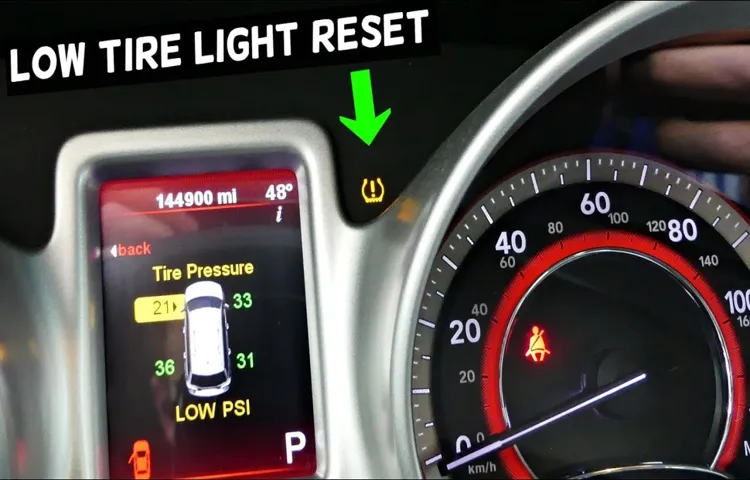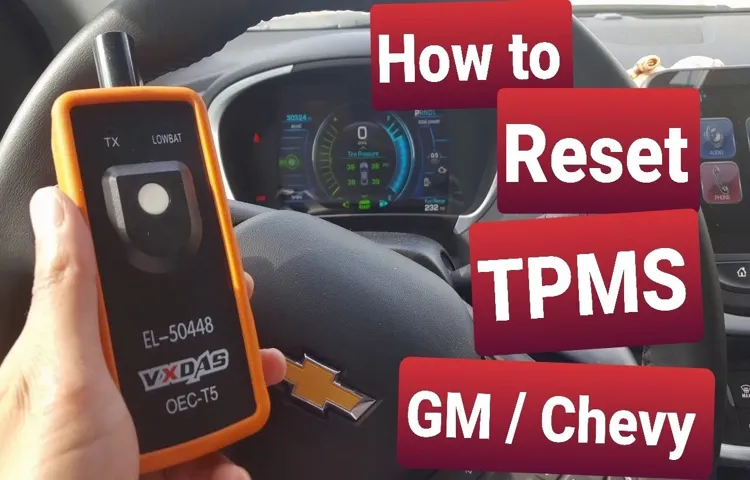Do you notice your tire pressure light on after getting your tires rotated? You’re not alone! Many drivers experience this confusion when their tire sensors need resetting after a tire rotation. It’s essential to reset the sensors to ensure they provide accurate readings for optimal safety on the road. But don’t worry; resetting your tire sensors is a quick and easy task that you can do right at home.
In this step-by-step guide, we’ll walk you through the process of resetting your tire sensors after a rotation. By the end of this guide, you’ll be driving worry-free!
Table of Contents
What are tire sensors and why is it important to reset them after rotation?
Tire sensors are devices that are integrated into your car’s wheels. They monitor the tire pressure and signal the driver if it falls below a certain threshold. It’s important to reset these sensors after rotating your tires, as they may become misaligned during the process.
This can cause inaccurate readings and trigger false alarms on your dashboard. To reset the sensors, you’ll need to consult your car’s owner manual or ask your mechanic for assistance. Typically, this involves pressing a button or following a sequence of steps on the dashboard’s interface.
By resetting your tire sensors after a rotation, you’ll ensure that your car’s monitoring system is functioning properly and avoid unnecessary trips to the mechanic.
Explanation of tire sensors and their function.
Tire sensors are electronic devices installed inside the tires of a vehicle to monitor the air pressure and temperature of each tire. These sensors are important for the safety of the driver and passengers. If the tire pressure is too low, the risk of a blowout or a flat tire increases, leading to a potential accident.
The sensors work by sending signals to a control module in the vehicle, which alerts the driver if tire pressure drops below a certain level. It is crucial to reset tire sensors after rotating your tires. Tire rotation involves changing the position of each tire to ensure even wear.
If the position of the tire changes, the sensors may send incorrect readings, indicating that the tire pressure is low, which can cause a false alarm. Resetting the sensors ensures that they are calibrated to the new position, giving accurate readings. In conclusion, tire sensors play an integral role in ensuring the safety and efficiency of a vehicle.
Regular maintenance, such as tire rotation and resetting the sensors, can prevent potential accidents and prolong the lifespan of the tires. Make sure to read your owner’s manual to understand how to reset the sensors properly or visit a professional mechanic to have them reset for optimal performance.

Why it’s important to reset them after a rotation.
Tire sensors are small devices that help your car’s computer monitor the air pressure in your tires. These sensors can improve your car’s performance and safety by making sure your tires are properly inflated. However, when you rotate your tires, the sensor positions can become mixed up, which can cause inaccurate readings, false warnings, or even complete failure of your tire pressure monitoring system.
That’s why it’s essential to reset your tire sensors after a rotation. By resetting your sensors, you can reprogram them to their new positions and ensure that they continue to function correctly. So if you want to make sure your car is running safely and efficiently, don’t forget to reset your tire sensors after a rotation.
How to reset tire sensors after rotation
After rotating your tires, it is important to reset the tire sensors to avoid any potential warning lights. The process to reset tire sensors may vary depending on the type of vehicle you have. Firstly, check your vehicle’s owner manual as it will guide you through the steps.
To reset the tire sensors, start by making sure all the tire pressures are correct. Once this is done, locate the tire sensor reset button, which is usually located on the dashboard or near the steering wheel. Press and hold the button until the warning light flashes, then release it.
If there is no reset button, you can reset the sensors by driving at least 15 miles per hour for several minutes. The sensors should automatically reset themselves. Keep in mind that it may take up to several miles of driving for the sensors to calibrate and begin functioning again.
By following these simple steps, you can reset your tire sensors after rotation and continue to drive safely without any warning lights.
Step 1: Check the owner’s manual.
If you’ve recently rotated the tires on your vehicle, you may need to reset the tire sensors to ensure accurate readings. The first step in doing so is to check the owner’s manual. The process may vary depending on the make and model of your vehicle, and the manual should provide specific instructions on how to reset the sensors.
In some cases, you may need to use a special tool to reset the sensors, while in others, the process can be done manually by following a specific sequence of steps. It’s important to follow the instructions carefully to ensure the sensors are properly reset and calibrated. By taking the time to reset the sensors after a tire rotation, you can ensure your vehicle is providing you with accurate information about your tire pressure and other important metrics.
Step 2: Use a TPMS tool.
To properly reset tire sensors after rotation, you’ll need to use a TPMS tool. This tool helps recalibrate the sensors and ensure that they are reading the correct tire pressure levels. Without this step, your car’s monitoring system may still display inaccurate warnings, making it hard to tell when the tires need inflation.
You can often find TPMS tools at your local auto parts store, or you can take your car to a mechanic who can perform the reset for you. Using a TPMS tool is a simple process, as the tool will walk you through each step. The key is to make sure that you follow the instructions closely and that you don’t skip any steps.
Once the process is complete, you can drive with confidence knowing that your tire sensors are working correctly and that you’ll be alerted if any issues arise.
Step 3: Drive the vehicle.
After completing tire rotation, the next step is to reset the tire sensors. This step is crucial because it ensures that your car’s onboard computer gets accurate tire pressure readings so that it can alert you if there are any potential issues. To reset the tire sensors, you need to turn on the ignition key and press the reset button near the steering wheel.
Hold the button for a few seconds until the tire pressure light flashes twice. After that, start the car and drive it at a speed of at least 50mph for around 10 minutes. This step recalibrates the sensors and re-establishes communication between them and the onboard computer.
Once you’ve done this, check to see if the tire pressure light has gone off. If it has, you’re good to go. However, if it hasn’t, you may need to repeat the process or take your car to a mechanic.
Overall, resetting the tire sensors after rotation is an essential part of tire maintenance that ensures optimal performance and safety on the road.
When you rotate your tires, it’s important to reset your tire pressure monitoring system (TPMS) to ensure that you get accurate readings. If your car has a TPMS reset button on the dashboard, you can use it to reset the system with ease. To do this, start by turning your car on and pressing the reset button, which will cause the TPMS indicator light to flash.
Once the light stops flashing, you’ll know that the system has been reset. However, if your car doesn’t have a reset button, you’ll need to consult your owner’s manual to find out how to reset the TPMS manually. This may involve using a sequence of button presses or driving your car for a certain distance at a certain speed.
Regardless of how you reset your TPMS, it’s crucial to do so after rotating your tires to ensure that your car is safe to drive. Remember to always check your tire pressure regularly to avoid potential hazards on the road.
What to do if the sensors still won’t reset
If you’ve tried rotating your tires and resetting the sensors, but they still won’t reset, there are a few things you can try. First, make sure that the tires are evenly inflated. Low tire pressure can cause issues with the sensors.
You can also try driving on the highway for a bit to give the sensors a chance to recalibrate. If those options don’t work, it might be time to take your vehicle to a professional mechanic. They can run diagnostic tests on the sensors to determine if there are any underlying issues.
Remember, properly functioning tire sensors are crucial for maintaining safe driving conditions, so don’t ignore any issues that arise. By taking the necessary steps to reset your tire sensors after rotation, you can ensure that your vehicle is running as smoothly and safely as possible.
Possible reasons why the sensors won’t reset.
If your sensors won’t reset, there could be a few reasons why. One possible issue is that the batteries are low or completely dead. Double-check to see if this is the cause by replacing the batteries with fresh ones.
Another reason could be that the sensors are not communicating properly with the hub or gateway, which could be a result of distance or interference. To troubleshoot this issue, try moving the sensors closer to the hub or gateway or making sure there are no obstructions in between. Additionally, make sure the sensors are properly installed and configured within your system.
If you’ve tried these troubleshooting steps and the sensors still won’t reset, there are a few more things you can try. First, consider resetting the hub or gateway itself, as this may help re-establish the connection with the sensors. You can also try resetting each sensor individually by removing the battery, holding down the reset button for at least 10 seconds, and then reinserting the battery while continuing to hold the button down.
If none of these methods work, it may be time to contact the manufacturer for further support. Remember to always read the manual and follow instructions carefully to avoid causing any damage to the sensors or your system. By staying patient and persistent, you’ll eventually be able to get your sensors back up and running.
Where to go for professional help.
If you’ve tried everything to reset your sensors and they still won’t cooperate, it may be time to seek professional help. While it’s possible to troubleshoot and fix some issues on your own, there are times when you need an expert to step in. First, check with the manufacturer of your sensors to see if they offer any repair services or can recommend a trusted technician.
You can also search for local companies or individuals who specialize in sensor maintenance and repair. It’s important to research and choose a company or technician with a good track record and positive reviews from previous customers. Remember, investing in professional help can save you time, money, and frustration in the long run.
Conclusion
In conclusion, resetting your tire sensors after a rotation doesn’t have to be a daunting task. It’s a simple process that ensures your vehicle’s safety and performance. Think of it like a reset button on your life – sometimes you just need a fresh start to get back on track.
So go ahead, press that button, and enjoy your newly rotated tires with peace of mind knowing that your tire pressure monitoring system is calibrated and ready to roll.”
Summary of the importance of resetting tire sensors after rotation.
After rotating your tires, it’s essential to reset the tire sensors to ensure that they function correctly. These sensors play a vital role in your car’s safety by monitoring the tire pressure and alerting you if there’s a problem. If you fail to reset them, you’ll get the wrong readings, and your car won’t perform as well as it should.
This can lead to issues such as lower gas mileage, premature wearing of tires, and increased risk of accidents. Resetting your sensors is a straightforward task that can be done at the dealership or with the help of an online guide. However, if resetting the sensors doesn’t solve the problem, you may need to replace them.
What to do if the sensors still won’t reset? If you’ve followed the steps to reset the sensors and they still aren’t working, it’s essential to take a closer look. One common issue is that the sensors may be damaged or malfunctioning. If this is the case, you’ll need to take them to a professional who can diagnose and repair the problem.
Another possibility is that the sensors are incompatible with your car’s make and model. In this case, you may need to purchase new sensors that are designed specifically for your vehicle. Whatever the issue may be, it’s crucial to address it promptly to ensure your safety and the safety of others on the road.
In conclusion, resetting your tire sensors after rotating your tires is crucial to maintaining your car’s performance and safety. If your sensors still won’t reset after following the steps, it’s essential to address the issue promptly by seeking professional help or purchasing new sensors. Don’t ignore the signs of malfunctioning sensors, as they can lead to severe consequences.
By taking care of your car’s sensors, you can drive with confidence and peace of mind knowing that your car is operating safely and smoothly.
FAQs
What happens to tire sensors during a rotation?
During a tire rotation, the tire sensors may get reset and need to be recalibrated.
Can tire sensors be reset manually?
Yes, tire sensors can be reset manually through a variety of methods, depending on the make and model of the car.
What are some common methods for resetting tire sensors?
Common methods for resetting tire sensors include using a reset button, using a magnetic device to trigger the reset, or using a diagnostic tool to reset the sensors.
Do all cars have tire sensors that need to be reset after a rotation?
No, not all cars have tire sensors. However, most newer vehicles do have them as they are required by law in many countries.
How often should tire sensors be reset?
Tire sensors should be reset every time the tires are rotated or whenever the car’s computer detects a discrepancy in the tire pressure readings.
What are the consequences of not resetting tire sensors after a rotation?
Not resetting tire sensors after a rotation can lead to inaccurate tire pressure readings and could potentially affect the car’s handling and fuel efficiency.
Can tire sensors malfunction after a rotation?
Yes, tire sensors can malfunction after a rotation due to a variety of reasons such as battery failure, physical damage, or electronic glitches.



